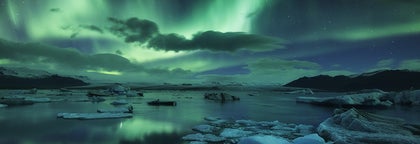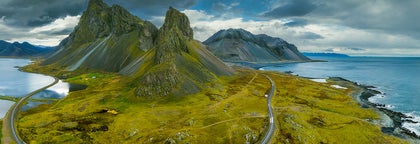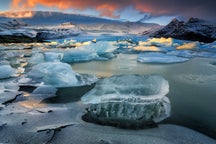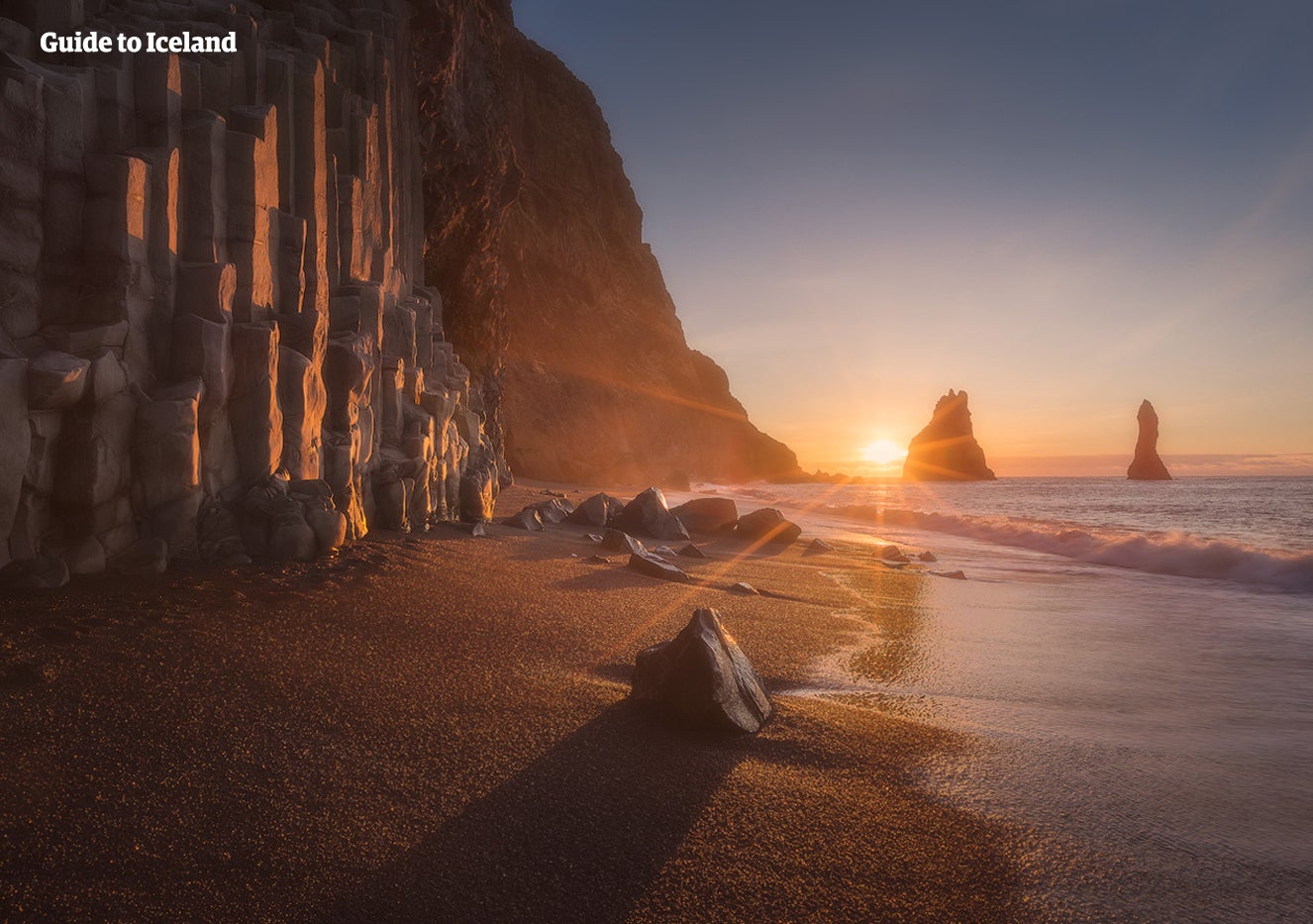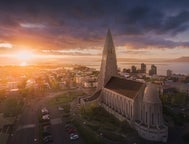
Best Ice Cave Tours in Iceland
Browse the largest selection of ice cave tours in Iceland. Discover glaciers from the inside and see the beautiful blue colors and patterns of the ice.
Find a unique experience
Select starting location
Select dates
Starting dateFinal date
Add travelers
1 traveler
Ice Cave Tours
Refine the results by using the filters
Sort by: Popular
We offer so much more
Explore an unequalled wealth of tours and packages
Frequently asked questions
What's the best ice cave tour in Iceland?
The best ice cave day tour is the one starting from Jokulsarlon glacier lagoon. The most popular multi-day tour with ice caving is this 2-day ice cave tour to Jökulsarlón glacier lagoon, as well as this 3-day south coast ice cave tour including the Golden Circle.
The most popular ice cave package tour in Iceland is a 5-day trip that visits the Blue Ice Cave in Vatnajokull National Park along with a trip to the South Coast, the famous Golden Circle, and the Blue Lagoon.
The most popular ice cave package tour in Iceland is a 5-day trip that visits the Blue Ice Cave in Vatnajokull National Park along with a trip to the South Coast, the famous Golden Circle, and the Blue Lagoon.
What are the most popular ice caves in Iceland?
The most popular ice caves in Iceland are the Katla Ice Cave, the ice tunnel of Langjokull Ice Cave, the spectacular Vatnajokull Ice Cave, and the remote Skaftafell Ice Cave.
What's the cheapest ice cave tour in Iceland?
The cheapest ice cave tour in Iceland starts from approximately 150 USD. This tour is a 4-hour small-group ice cave tour that starts at the Skaftafell Visitor Center and takes you to the Vatnajokull glacier, where you will experience both ice caving and glacier hiking. If you are located in Reykjavik, it's about a 4-hour drive to Skaftafell Visitor Center.
Where can I see a crystal blue ice cave in Iceland?
You can see a crystal blue ice cave in Iceland under the Vatnajokull glacier, accessible on guided tours from the Jokulsarlon glacier lagoon, such as this best ice cave tour in Iceland.
How do ice caves form in Iceland?
Ice caves in Iceland form when summer meltwater flows into a glacier through cracks and then finds its way out. Most ice cave tours in Iceland are only available in winter when the caves are more stable.
When can I visit ice caves in Iceland?
Some ice cave tours, such as the Katla Ice Cave and the Langjokull Ice Tunnel, can be explored year-round. Other more vulnerable ice caves, such as the Vatnajokull ice cave, are only safe to visit during the winter months in Iceland.
Are the ice caves in Iceland worth it?
Definitely, visiting ice caves in Iceland is truly a unique experience that transports you to an otherworldly place you won't forget. The photography opportunities are also amazing, and some ice caves are only accessible during the winter, making the experience even more exclusive.
Are ice caves in Iceland safe to enter?
Yes, ice caves in Iceland are safe to visit because experienced glacier guides and experts regularly check them for stability. You can only visit these caves on a guided ice cave tour with a trained expert.
Can you visit ice caves in Iceland on your own?
No, you should never visit an ice cave in Iceland without a professional guide, as it can be dangerous.
Can I visit the ice caves in Iceland in late October?
Some ice caves in Iceland are open in late October, but it will depend on the weather conditions each year. The Katla ice cave is, however, open year-round.
Are ice cave tours in Iceland available during Christmas?
Ice cave tours under the Vatnajokull glacier in Iceland run from October to March, including the Christmas season. Most tour operators offer tours during the holidays to accommodate visitors.
How much time will I spend inside the ice cave in Iceland?
Most ice cave tours in Iceland spend around 40–50 minutes inside the cave, admiring the glacier walls and ice formations as you learn about them.
Is a glacier hike included in the ice cave tours in Iceland?
A glacier hike is not included in a standard ice-caving tour in Iceland. However, you can find them in several multi-day tours and vacation packages.
For example, in summer, you can enjoy glacier hiking on this 2-day tour to Jokulsarlon Glacier Lagoon or this 5-day Golden Circle and Glacier Lagoon package.
In winter, this 8-day guided northern lights tour will take you along the unforgettable Ring Road to see Iceland's most magical destinations and, of course, go on an adventurous glacier hike.
For example, in summer, you can enjoy glacier hiking on this 2-day tour to Jokulsarlon Glacier Lagoon or this 5-day Golden Circle and Glacier Lagoon package.
In winter, this 8-day guided northern lights tour will take you along the unforgettable Ring Road to see Iceland's most magical destinations and, of course, go on an adventurous glacier hike.
What is the best ice cave tour from Reykjavik?
The best ice cave tour starting from Reykjavik is this exhilarating 10-hour ice caving tour in Langjokull glacier. It includes transport to the glacier, a knowledgeable guide, and a monster truck ride on the glacier itself while getting to the ice cave. That makes for a day you won't forget!
How long is an ice cave tour in Iceland?
While your time inside the ice cave is around 45–60 minutes, depending on the tour, most Iceland ice cave tours are at least 4–5 hours since it takes time to put on proper equipment and hike towards the ice cave itself, which is located inside a glacier.
Are snowmobile and ice cave tours available in Iceland?
Yes, there are several great snowmobiling and ice cave tours available in Iceland, such as this incredible 4-hour snowmobile and ice cave tour in Langjokull glacier.
Do you offer a photography ice cave tour in Iceland?
Yes, we offer photography tours in Iceland, such as this small-group 3-hour ice cave tour with a professional photo package.
How cold are the ice caves in Iceland?
The temperature inside the ice caves in Iceland is around 32°F (0°C) and can get as cold as 14°F (-10°C) in some parts. That is why it is important to wear warm clothes, hats, and gloves when visiting an ice cave, even during the summer.
Will there be daylight if we visit the ice caves early in the day in mid-winter?
Yes, it can take about 4–5 hours to reach the ice caves in Iceland from Reykjavik. By the time you arrive and gear up, the sun will be up, and you'll be ready to start exploring the caves.
How much do ice cave tours cost in Iceland?
Ice cave tours in Iceland start from around 140 USD, like this amazing ice cave tour in Vatnajokull, and can run up to thousands of dollars for private and exclusive tours.
What should I wear for an ice cave tour in Iceland?
For ice cave tours in Iceland, it is essential to wear warm, waterproof layers, including a thermal base layer, an insulated jacket, and sturdy, waterproof boots with good grip. Gloves, a hat, and a scarf are also recommended, as conditions inside the caves can be cold and slippery.
Will there be any climbing tools necessary to explore the ice caves in Iceland?
Unless your tour description explicitly says so, you won't need climbing tools to explore Iceland's ice caves. If your tour includes some ice climbing activities, it will say so in the tour's description, and the tour company will provide you with any tools you might need.
Are ice cave tours in Iceland suitable for children?
Many ice cave tours in Iceland are family-friendly, though age restrictions can vary by tour. For safety reasons, some tours may only allow children above a certain age, so it’s best to check with the minimum age on each tour. One of the best ice cave tours for families with children is the classic Into the Glacier tour, which has no age restrictions.
How physically demanding are ice cave tours in Iceland?
The physical demands of an ice cave tour in Iceland vary. Some caves require glacier hiking, which can be challenging, while others only involve short walks. Check the tour description to see the fitness level required for each individual tour.
What happens if the weather is bad on the day of my ice cave tour?
If the tour operator deems the weather too dangerous, the ice cave tour may be canceled or rescheduled for another day. If the tour is canceled because of bad weather or rescheduled and you can't make it to the new date, you will always receive a full refund.
When is the best time to visit ice caves in Iceland?
The best time to visit ice caves in Iceland is during the winter months, from November to March. During this period, the caves are more stable and accessible due to colder temperatures.
Where can I find ice caves in Iceland?
Iceland's ice caves can be found all across the island, but some of the most popular and accessible ones are located in Vatnajokull National Park, near Jokulsarlon Glacier Lagoon. Other notable ice caves can be found in Langjokull Glacier by the Golden Circle, and the Katla cave (open all year) is close to the southern town of Vík.
How can I visit an ice cave in Iceland?
Visiting an ice cave in Iceland is possible by joining a guided tour. These tours are led by experienced guides who are knowledgeable about the caves and local conditions. Guided tours ensure your safety and provide you with valuable information about the caves and their formation.
Can I visit ice caves during the summer?
Yes, you can visit the Katla ice cave and the glacier tunnel in Langjokull during the summer months in Iceland. However, most other ice caves are only accessible in winter when the ice is most stable.
Are ice caves wheelchair accessible?
Ice caves in Iceland are typically not wheelchair accessible due to the challenging and uneven terrain, as well as the need to navigate narrow passages or climb in some cases.
If you have specific accessibility concerns, contact us at info@guidetoiceland.is to discuss possible accommodations or alternatives.
If you have specific accessibility concerns, contact us at info@guidetoiceland.is to discuss possible accommodations or alternatives.
Can I take photographs inside the ice caves?
Yes, photography is allowed in ice caves, and they provide stunning opportunities for capturing unique and beautiful images. Be sure to bring a camera suitable for low-light conditions, and always follow your guide's instructions for safety and conservation purposes.
Do I need to book an ice cave tour in advance?
Yes, it is highly recommended to book an ice cave tour in advance, especially during the peak winter season when tours can fill up quickly. Booking in advance ensures you have a spot on the tour and can help you plan your trip more effectively.
Is it possible to combine an ice cave tour with other activities in Iceland?
Yes, many tour operators offer combination packages that include ice cave tours along with other popular activities, such as glacier hiking, snowmobiling, or Northern Lights hunting. These packages can provide a more budget-friendly and easy way to experience the diverse attractions that Iceland has to offer.
Are there restroom facilities at the ice caves?
Restroom facilities at ice cave locations are usually limited or unavailable. It's best to use restrooms before starting the tour, either at the base where you change into glacier gear or at nearby facilities.
Can I take a private ice cave tour in Iceland?
Yes, you can absolutely book a private ice cave tour in Iceland, such as this private five-hour winter ice caving tour. These tours often provide a more personalized experience and can be tailored to your preferences and needs.
Is there a maximum group size for ice cave tours?
The maximum group size for ice cave tours in Iceland varies between tour operators and may depend on the specific cave location. Group sizes can range from 8 to around 20 participants.
Are ice cave tours suitable for seniors?
Ice cave tours can be suitable for seniors, depending on their fitness levels and the specific tour's difficulty. Some tours involve short walks on flat terrain, while others require more strenuous hikes or climbing. A great option for seniors to join an ice cave tour is this Into the Glacier ice cave tour with Hraunfossar waterfalls starting from Reykjavik.
How far are the ice caves from Reykjavik?
The distance from Reykjavik to popular ice cave locations varies. For example, ice caves in Vatnajokull National Park are approximately 230 miles (370 km) from Reykjavik, about a 4.5-hour drive in optimal road conditions. Some tours include transportation from Reykjavik or nearby towns, while others require you to meet at a specific location closer to the cave, like in the town of Vik.
Can I use a drone to capture footage during an ice cave tour?
Drone use is often restricted or prohibited in many natural areas in Iceland, including ice caves and their surroundings. Always check with the tour guide and follow local regulations regarding drone use. In many cases, drones are not allowed due to safety concerns and potential disturbances to the environment and wildlife.
What types of ice formations can I expect to see inside the caves?
Inside ice caves, you may encounter various ice formations, including icicles, frozen waterfalls, and layers of blue, white, or even black ice, created by the compression of ice and incorporation of volcanic ash. The specific formations and colors can vary depending on the cave and time of year.
How do I choose the right ice cave tour for me?
When choosing an ice cave tour, consider factors such as the tour's difficulty level, duration, location, and group size. Also, take into account the time of year and your personal interests, fitness level, and travel plans.
What is the best time of year to visit ice caves in Iceland?
The peak season for ice cave tours is from November to March, when the ice is most stable. Some caves, like those in Langjokull and Katla, are accessible year-round due to either man-made construction or specific geological conditions.
Do ice caves in Iceland look the same every year?
No, ice caves in Iceland are mostly natural formations that change each year due to melting and refreezing. This means each visit can offer a different experience, even if you visit the same glacier multiple times. However, some ice caves, such as the ice tunnel in Langjokull glacier, are man-made and look similar year after year.

Install Iceland’s biggest travel app
Download Iceland’s biggest travel marketplace to your phone to manage your entire trip in one place
Scan this QR code with your phone camera and press the link that appears to add Iceland’s biggest travel marketplace into your pocket. Enter your phone number or email address to receive an SMS or email with the download link.

























